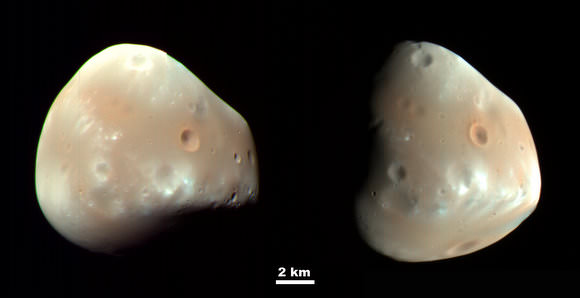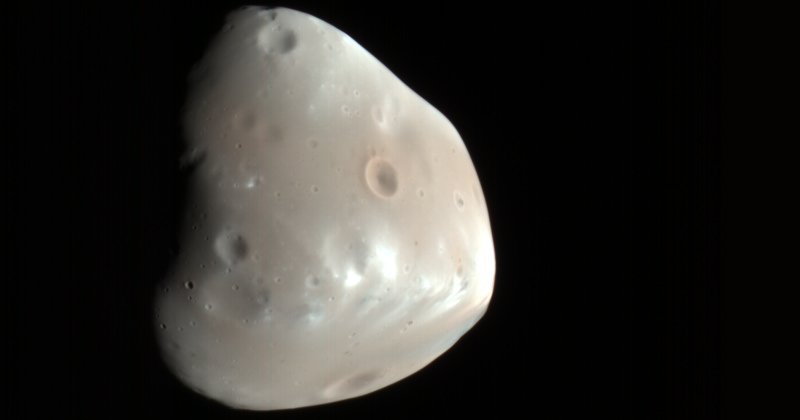[/caption]
Don’t panic – its only Deimos. But what an image this is of the smaller moon of Mars! HiRISE captured this enhanced-color image of Deimos on February 21, 2009, showing the moon’s smooth surface – with a few impact craters here and there. The one crater near the middle that looks sharp and crisp was created relatively recently. Deimos is composed fragmental rock, or regolith, rich in carbonaceous material, much like C-type asteroids and carbonaceous chondrite meteorites. Deimos is noticeably smoother than Phobos. (See images of Phobos taken by HiRISE in 2008). HiRISE took two images of Deimos, about five and a half hours apart – see below.

These images have a scale of about 20 meters/pixel, so the features 60 meters or larger can be seen. The images were acquired 5 hrs 35 minutes apart, so the sun was to the upper left in the first (left) image and to the right in the second image. Although the viewing geometry is similar in the two images, surface features appear very different due to the changes in illumination.
There are subtle color variations—redder in the smoothest areas and less red near fresh impact craters and over ridges or topographic highs (relative to its center of gravity). The HiRISE scientists say these color variations are probably caused by the exposure of surface materials to the space environment, which leads to darkening and reddening. Brighter and less-red surface materials have seen less exposure to space due to recent impacts or downslope movement of regolith.
Deimos is named after a figure in Greek mythology representing panic or dread. Only two geological features on Deimos have been given names: the craters Swift and Voltaire are named after two writers who speculated on the existence of Martian moons before they were discovered.
More about the operations of taking the images from the HiRISE team.
Source: HiRISE


What is causing the crater wall erosion?
Micrometeorites, hard radiation coming from the sun, even the light itself can cause erosion in exposed surfaces, through photochemical reactions.
Possibly the very, very tenuous but still there atmosphere too?
Nope. Deimos is way too small to have an atmosphere of its own.
could these asteroid moons be loose piles of rubble rather than solid rock? if so, would it still be possible to land a probe there?
so… those are true colors?
Jorge I think that Kevin says that Deimos migth still have some influence of Mars atmosphere.
@ Jorge,
Thank you.
@Olaf and Jorge – that’s what I meant. 🙂
@That really awesome guy (really? ;))
I think I’ve read somewhere that some folks propose that idea, that both Phobos and Deimos are piles of rubble instead of solid rocks. They are pretty different from the only rubble pile that has been photographed up close, though: Itokawa. So I don’t know. Regarding landing, well, Hayabusa did land on Itokawa. And NEAR Shoemaker also landed on Eros, which is more or less the same size as Deimos. So it’s possible.
@Eduardo:
Nope. They are enhanced colours, I think.
@Olaf and Kevin:
Ah, I see. Sorry for the misunderstanding. So… Mars atmosphere, at that altitude? I dunno. 23 thousand km is quite distant for the thin martian atmosphere to have any significant impact on Deimos. But I can’t say.
I really think Demios should be demoted to the rank of a ‘moonette’. I has about as much gravitational attraction as a large potato. (In fact it even reminds me of Mr. Potato head – I can just imagine it with a moustache, glasses, a silly hat and a big nose)
Lets face it, its not even a sphere, its like a large pebble on the beach.
I’m sure my gran walks further than that during a ramblers convention on a Sunday afternoon.
@ Edwardo
“so… those are true colors?”
Color in photo presentation has always been a issue for me too, especially the deep field views of HST and the SDSS and now Spitzer. Are we looking at Doppler shift, true chemical composition? Or is it a filtered composite? Maybe even some “photo shop” rendering/enhancing on the authors part? Or, a combination of any or all of the above.
I think that any photo, especially astronomy photos, should disclose this information when presented in articles. Just MHO.
Rubble piles are also smoothed by the vibrations of later impacts – it “shakes it down” a bit. Isn’t Deimos scheduled to impact with Mars in the distant future?
For certain, what you would see with the naked eye would be different. I would wager that the exposure time is increased to get details. In a sense, it is over-exposed. In person, it would probably be a dark reddish black.
If you have seen the picture of the Earth and the moon taken from (i think) Messenger, you will notice that with the bright Earth in the frame, the actual dark brown of the moon is what is shown…
Deimos seems to have a somewhat ‘melted’ appearance.
Possible melting scenarios might include:
1) A pass thru the Martian atmosphere back when it was captured?
2) Close passage by Sol, prior to being captured by Mars.
3) The surface has an accumlation of dusty particles, similar to what was seen on Eros?
4) Decomposition of the surface by solar radiation – elemental composition dependent.
5) neoguru’s comment: “Rubble piles are also smoothed by the vibrations of later impacts – it “shakes it down” a bit. ” seems the most plausible.